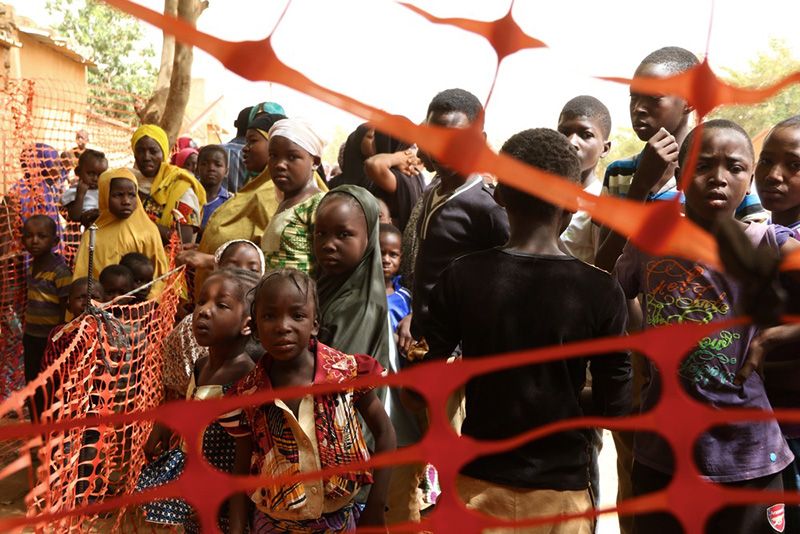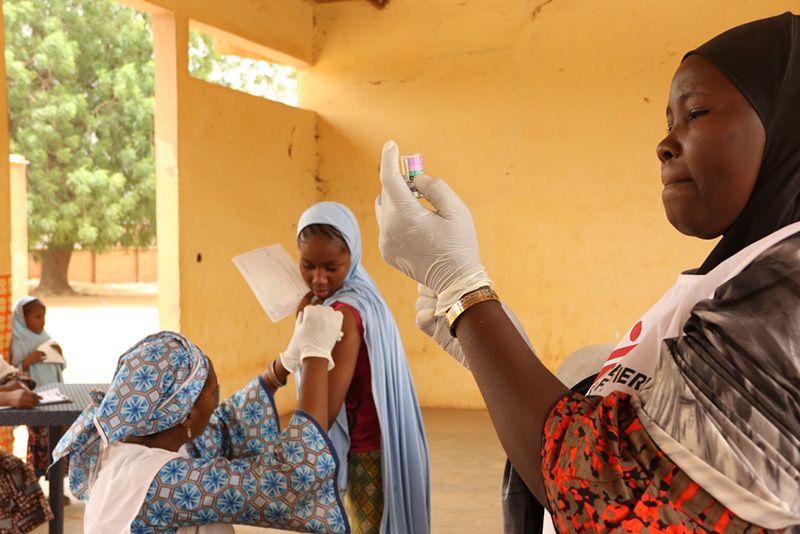Interview with Miriam Alía, MSF vaccination and outbreak response advisor, specialised in meningitis. Miriam is one of two MSF staff working in the International Coordinating Group (ICG) on Vaccine Provision.
There are now declared outbreaks of meningitis C in Niger and Nigeria. Why are these types of outbreaks recurring in this region?
People can succumb to meningitis all year round, but this region’s dry and windy climate between December and May allows it to spread even more. The infection is transmitted through droplets of saliva, and this type of climate irritates the throat. As such, it stops acting as a barrier against the bacteria. With the arrival of the rainy season, transmission is reduced and the number of cases decreases exponentially.
The best solution for avoiding these outbreaks would be to vaccinate people, just like we do for measles. But unlike measles, which has a single type of vaccine that works well, there are many different vaccines for meningitis. Firstly, there are different types of meningitis and you need to identify the serogroup that causes the outbreak: A, B, C, W135, X or Y. Some vaccines only work for one serogroup, whereas others can work for up to four. Unfortunately, there is insufficient vaccine production to preventively vaccinate against all types of meningitis.
What types of vaccines are currently available for meningitis?
On the one hand, we have polysaccharide vaccines –a first generation of vaccines– that are inexpensive, simple to produce and prevent transmission. However, they are only effective for three years and also don’t prevent healthy carriers. We also have conjugates –a new generation of vaccines– that are also effective in healthy carriers and provide a more prolonged immunity, but they are more expensive.
The first conjugate vaccine that was used on a large scale was the MenAfriVac, a vaccine developed by the Serum Institute of India, which was very cheap and effective and managed to halt the explosive outbreaks of meningitis A that were occurring in the region in the 1990s and 2000s. Thanks to the collaboration of the Bill Gates Foundation, UNICEF, and the WHO, mass vaccination campaigns were developed for people aged between 1 and 30 years old, and it is progressively being introduced into routine vaccination schedules in these countries. It is estimated that more than 260 million people have been vaccinated with MenAfriVac since 2009.

Why not do the same mass campaign for meningitis C?
After the great success with the meningitis A vaccine campaign, we did not expect similar epidemics of other serogroups. In 2013 and 2014, however, there were already meningitis C outbreaks in northwest Nigeria, and in 2015 there was a huge outbreak affecting Nigeria and Niger. In addition, this was from a highly virulent serogroup C. We had never dealt with a meningitis C outbreak as big as this, and the production of vaccines was insufficient. Nor do we have a long-term protection vaccine that is as cheap as MenAfriVac for meningitis C.
Right now, the Serum Institute of India is working on a vaccinated pentavalent conjugate (A, C, Y, W-135, X) which, in theory, will be available for 2020. If it is as effective and safe as the MenAfriVac—which can also be used for 4 days outside of the cold chain—we will be dealing with a super vaccine. The perverse effect of this is that other laboratories are not going to produce many vaccines because if they don’t use them beforehand they know that they will not have a market for them.
Are there enough vaccines to tackle the current meningitis C outbreaks?
After the meningitis C outbreak of 2015, the ICG established a minimum stock of five million vaccinations for serogroup C. However, we didn’t reach that figure in 2016 or this year. There isn’t as much production and laboratories will not risk producing a vaccine that is sold only if there is an epidemic and has a market only until 2020. Thus, the available vaccines can only be used reactively when an outbreak is declared, and not preventively in risk areas in order to avoid it. This year, epidemics have been declared in eastern and western Nigeria and various parts of Niger, and there has also been a small outbreak in Togo.
The ICG has already supplied several shipments of meningitis C vaccines to Niger and Nigeria this year. In some cases these are polysaccharides, and for the first time, there are also conjugates. But we have had to reduce the number of vaccines from the original request or reduce the target age group, because for yet another year we are dealing with the problem of vaccine shortage, despite having purchased all the available stock. The epidemiological criteria that regulates where and which population group to vaccinate are very strict in order to respect the principles of equity on which the ICG is based.

How does the ICG work?
The ICG was created in the 1990s to manage vaccines that were not mass-produced and to distribute them according to epidemiological and equity criteria. The WHO, UNICEF, the Federation of Red Cross and MSF are part of the organisation. Right now, the ICG manages the vaccines for yellow fever, meningitis, and cholera; the first two of which are only used reactively, in response to outbreaks. To ensure that there is production, the ICG buys the vaccines in advance according to predictions, even if they are not guaranteed to be used.
When an outbreak occurs, the country’s Ministry of Health needs to send a request to the ICG, and an answer needs to be given within 48 hours. The answer is based on whether or not there is a declared outbreak, or cases close to an area with an outbreak. Once this is taken into account, the demand is either totally or partially approved or rejected. Besides vaccines, the ICG can also supply the injectable material and treatment.
How do you respond to this type of outbreak?
When cases of meningitis start to appear, it is very important to be able to quickly identify the type of serogroup. To find out the serogroup, a lumbar puncture needs to be done, which in many African countries can only be performed by doctors, and it may significantly delay the process. Once the sample is obtained, we have a rapid test, but confirmation is also required from a laboratory by culture.
In order to respond to an outbreak, we must reinforce epidemiological surveillance, ensure case management, vaccinate whenever possible and raise awareness in communities, so that the cases can be treated promptly by the health infrastructure. If they go without treatment, half of the people who contract the disease die; with treatment, the mortality rate can reach 10%. To avoid this, it is essential that ill people are treated as soon as possible.
Read more about MSF's activities in Niger and Nigeria.
Meningitis causes an inflammation of the meninges, the fine membranes that cover the brain and the spinal cord. The disease may be of viral or bacterial origin, but while viral meningitis is usually benign, bacterial meningitis (caused by the bacterium Neisseria meningitis) is serious and can be fatal.
According to the World Health Organization, around one million suspected cases have been reported in the last 20 years and 100,000 people have died. The most affected region is Africa.